Battle Realms, the first product from Liquid Entertainment, has style in spades--everything about it is slick, and it's noteworthy for that reason alone, as well as for many others. It's a martial-arts-themed real-time strategy game featuring dozens of great-looking units from four unique factions, impressive graphical effects, and an innovative resource model. It has a polished, attractive presentation, an open-ended campaign, and several good multiplayer modes. Battle Realms does have a few gameplay issues that diminish some of its strategic appeal, as the action can prove to be difficult to manage. But it's still a very worthwhile experience despite these things and should provide many hours of enjoyment for all kinds of real-time strategy players.

The setting and characters of the game are clearly inspired by some of Hong Kong's most spectacular martial arts films--particularly the work of director/choreographer Tsui Hark--as well as some of Japan's action-packed comics and animated films, like the gory and stylish Ninja Scroll. The incredible fight sequences featured in last year's film Crouching Tiger, Hidden Dragon are also a good frame of reference for what you can expect from the battles in Battle Realms. Nothing is mundane in the game's fictional Far East-like world--even simple peasants can fight as trained martial artists should the need arise. All the game's various units and characters don't just stand adjacent to each other and hack away, as in most other real-time strategy games. Instead, they'll attack with a variety of moves and techniques and put on quite a show in the process. Thanks to the game's beautifully animated fully 3D units, not to mention the attractive terrain graphics and the overall detail found in the game, Battle Realms certainly looks impressive.
True to its source of inspiration, combat in Battle Realms can be quite chaotic. You actually have little control over your units besides being able to move them about (you can make them run by double-clicking), order them to attack, and initiate their special abilities if they have any. It's surprising that you can't do more with your units. They're very autonomous--they'll automatically rush to attack nearby foes, prioritize threats properly, and even switch between ranged and melee attacks as necessary. The pathfinding in the game is great--tell your units to go somewhere, and they will, stopping to fight any enemies along the way. But you can't set your units in formations and must instead move them as a rabble (though the rabble moves at the speed of the slowest unit in the group); and the pacing of the combat can be so fast that you'll just have to wait and see whether your forces survive. It can be very difficult to pull units out of battle, as they will seem to keep trying to lurch back into the fray. Also, since the game's units are large and tend to spread out when they fight, it can be all the more difficult to keep track of everything that's happening in a big battle, since it won't all fit onscreen.
Micromanaging the combat is necessary to sway the odds in your favor--individual units can have special abilities or equipment that can be used in battle to debilitate their foes, bolster their allies, and much more. Still, the breakneck pacing of the combat will often force you to simply use all of your special powers and abilities all at once, hoping for the best. But not all of the game is this fast-paced--it can take a while to bring enemy structures to the ground, during which time the enemy can flee with a few peasants and set up a new base of operations elsewhere, making the battle drag on.
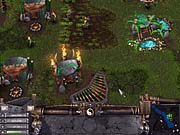
The peasant, your basic unit, is automatically produced from peasant huts it can build. The more peasant huts you have, the faster peasants are generated. But the more units you have, the slower peasant generation becomes, until you reach your maximum unit limit--up to 50. Peasants can build other structures and can also gather the game's two resources, rice and water. New buildings cost a surplus of rice and water. Training new units costs rice and water too.
The resource model is slightly more complex than that--rice grows back slowly, but it'll grow back faster if you have peasants water it. And you don't just buy military units as you do in most real-time strategy games--your peasants train themselves into them. Thus, the resource gathering in Battle Realms becomes a challenging proposition. The more peasants you have, the more resources you can gather--but unless you upgrade peasants by training them to be troops, you'll be defenseless. It's an interesting system, especially once you factor in some of the finer details, like rains suddenly replenishing all your rice paddies or having to use water to put out buildings that have caught fire. Fortunately, the building process moves quite briskly in Battle Realms, and since there are fairly strict upper limits on how much rice and water can be stored, you'll have a good sense of when your economy is well underway and be able to commit to military training.
Still, you'll have to pay a lot of attention to your economy at all times. Though peasants ordered to harvest rice, fetch water, or water rice will continue to do so, as more peasants become available, you'll need to deal with them individually. You'll need to send them into basic training facilities to produce your basic fighting units--for instance, the cruel Serpent Clan can produce swordsmen by sending peasants to the tavern (in an amusing touch, you see things like "@*!#?" spewing forth from the tavern, which signifies that it's occupied by an apparently none-too-pleased swordsman in training). To create more-powerful units, you then send your new fighters into other training facilities. The swordsman can then be upgraded by training him to be a bandit (who can loot the corpses of his foes for some rice and water) by sending him to the sharpshooter's guild.
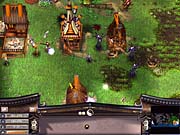
You'll need to go through three, four, or even five steps to produce some of the more advanced combat units. The bandit can then become a ronin, who fights with two huge blades; and four ronin can then be sacrificed to form a powerful necromancer, whose mere presence causes all the fresh corpses around him to rise up as zombies under his command. Unlike in other real-time strategy games that let you build high-end production facilities to produce your strongest forces directly, in Battle Realms, you must go through the same incremental process each time you want to train one of your stronger units. So you can't just make a bunch of ronin from scratch. Fortunately, what you can do is set rally points from one training facility to another just by right-clicking to create a sort of production line. You can even set rally points from peasant huts straight to resource patches or training facilities. This way, you can leave your town be for a while--but your peasants will still make themselves useful and automatically train up to whatever unit you desire.
The rally points are a good thing, but of course, you'll often want to pick and choose which units to make, as well as when to make them. This can be a bit of a hassle since the minimap on the interface doesn't distinguish between buildings, units, peasants, or much of anything. You'll just see a big, colored blotch to indicate the concentration of your forces. In reality, your buildings are huge and spread out. Once you've built up your town, expect to have to manually scroll around it a lot, looking for stray units. Fortunately, there's a prominent button on the interface for zeroing in on idle peasants (and also on battles underway or on buildings caught on fire). And you can queue up peasants or other units for training at particular structures. Only one unit at a time can train in each structure, but the rest will wait their turns.
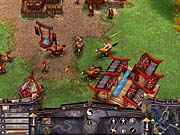
Battle Realms' resource model is mostly very well designed, and the game has a lot of other great concepts as well. One is that virtually any unit can ride on horseback (though the Wolf Clan prefers to use horses for food). Peasants have a few additional roles, including repairing damaged buildings, putting out fires, and taming horses, which can be found out in the wild. These can then be brought back to a stable you've built, and any of your units can then use them as a steed. The animation of units on horseback looks simply outstanding. Units can fight with increased effectiveness from the mount, and the horse itself can even use a trample attack against nearby enemies. Horses also effectively give your units extra hit points (your units don't take damage until the steed is killed) and of course help you cover more ground quickly, but they aren't strictly necessary in battle.
Another option you have is to build certain structures that can outfit your troops with special limited-use equipment. This lets you upgrade units individually, but for an individual fee. It can give you a surprise advantage against an opponent unaware of the trick you have up your sleeve. For instance, the swordsman can purchase an enchanted glass sword that can kill a foe outright, but it shatters in the process, damaging the swordsman himself. Archers and other long-range fighters can purchase specialty arrows and darts. This equipment necessitates still more micromanagement. Not only do you have to individually equip your troops, but you also must keep track of who has what and when to use it, and there's no clear visual indication of which troop has battle gear. Still, using the appropriate battle gear is what will separate an advanced Battle Realms player from another, and this feature definitely adds some depth and a long-term learning curve to the game.
There are other ways to upgrade your forces. As you fight, you gain "yin" or "yang" points, depending on your faction. This roughly corresponds to battlefield experience, honor, or what have you. Typically, the farther away from your home territory when you're fighting, the faster you'll earn these points. This gives the aggressor the advantage so that players don't just resort to hunkering down, waiting for their opponents to make the first move. Yin and yang points can then be spent to upgrade certain classes of units--to make them stronger, more damaging, faster, have more range, and so on. It's another interesting facet of the game--you don't just buy unit upgrades as in other real-time strategy games, but you earn them by taking the initiative in battle. You'll have to pick and choose upgrades, especially at first, and depending on which units you improve, you can emphasize different types of units in your armies.
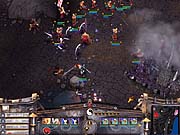
One of the side effects of having so many seemingly powerful units in Battle Realms is that their roles aren't always obvious. Every unit can fight hand-to-hand; the Dragon Clan cannoneer is basically a sumo wrestler with a huge wrought-iron cannon and will bash you over the head with that thing if he's too close to shoot you with it. Units that can fight from long range will do so if you order them to hold their ground, even if their melee attack is stronger. When you have so many multipurpose units available, you might not have an intuitive sense of which of these to send into the fray. This is especially true of the Lotus Clan, whose gangly, undead forces don't have obvious roles; and the Wolf Clan, all of whose units are gigantic and fierce-looking.
You'll eventually realize that a mixed army, including specialized melee fighters, archer units, a couple of healers, and maybe a support unit or two, will lead to the best results. Clans also have fire-starting units that are best suited for razing enemy structures. All four clans look and sound different (down to their interfaces), and they have very different units, different structures, and different battle gear. The resource model is the same for all four, though, as is the underlying strategy. But even though you'll figure out eventually which unit of each Clan does what, you'll wish the game provided more information about exactly what's going on. Battle Realms hides a lot of statistical information from the player--it's evident that there are different types of unit armor, different types of damage, and more. Yet it's unclear either from the game or from the well-written manual exactly how powerful each unit is, what certain upgrades do, and so on. Real-time strategy games such as Starcraft and Age of Empires II do an excellent job of giving you at-a-glance information on how powerful each unit is and what upgrades it has, giving you the raw data that helps you determine a good strategy. Battle Realms, with its decidedly unusual units, would have benefited from this approach.
Battle Realms features some tutorial scenarios to give you a grasp of the game's distinct style and some of its unique features, a complete skirmish mode that lets you play against up to seven computer-controlled opponents, and a branching campaign. The campaign tells the story of Kenji, a mighty swordsman returned from a period of exile after apparently murdering his own father. Early on in this campaign, you make a choice that determines whether you are good or evil in your disposition, which decides whether you'll lead either the noble Dragon Clan or the wicked Serpent Clan thereafter. You'll later square off against the Lotus and the Wolf either way, but these other two clans are fully playable in skirmish and multiplayer battles.
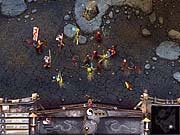
Between campaign missions, you'll have options to advance into different provinces, effectively choosing different missions that lead to different plot branches. The campaign uses in-engine cutscenes that are zoomed in too close for comfort to the game's units, and this is perhaps the only thing about Battle Realms that doesn't look good. Otherwise, the story itself is fairly engaging, thanks to the sense that you are making meaningful decisions, as well as the generally good voice acting for Kenji and the other characters.
The campaign missions themselves can be a bit drawn out. You'll almost always have to build a town from scratch and will often have to clear all the enemy forces from the map to win. Finding the last scraps of resistance or that last peasant hut can be time-consuming. Still, the computer provides a good challenge both in the campaign and in skirmish battles. It will use shrewd tactics to do you in--you'll notice how it sometimes attacks from two directions, aims for weaknesses in your defense, goes straight for your peasants if it can, or even uses a fast unit to goad your defending forces into pursuit, leaving your town vulnerable. The computer makes a worthy opponent, and as a result, the later campaign missions can be tough, though you do have an option to tweak the difficulty.
You can also play against up to seven human players using the game's integrated GameSpy player-matching service, which seems to have some problems finding open games--but at least you can use its chat features to facilitate a match using direct-IP. Both in multiplayer and in the skirmish mode, there are plenty of maps of all sizes to choose from (no scenario editor is included, though), and there are also a few discreet modes of play available. Some of these are designed to curtail some of the lengthy endgame sequences found in the campaign missions. In one mode, all you have to do to win is raze the enemy keep. Another mode, called famine, eliminates the economic aspects of Battle Realms by giving you a large surplus of water and rice with which you'll need to assemble a formidable army. You can never earn more resources, so this becomes an exercise in careful spending and battle micromanagement and thus can make for a good diversion from the core gameplay.

Micromanagement has become sort of a taboo in real-time strategy gaming, but you probably won't mind micromanaging the battles in Battle Realms because your units will basically do a good job on their own, and you'll enjoy scrutinizing the combat anyway. The units have tons of personality in their every move--for example, the Wolf Clan's ballistaman stands hunched over, with a giant crossbow on his back. He sticks out like a sore thumb from his peers, who shun technology. But when he cranks up that machine of his, flips a big bolt into the slide, and lets it loose, you'll see why even the austere Wolf Clan doesn't mind having him in its arsenal. Meanwhile, the Lotus Clan's infested ones are truly disgusting--these fat, maggot-ridden walking corpses attack by throwing their innards, complete with flesh-eating maggots, at their foes. The ranks of the Dragon Clan and its rival the Serpent Clan are filled with slightly less unusual, though no less impressive, units. Appropriate voices are used for all of them, though you'll wish they had more to say individually. The other sound effects in Battle Realms--most notably the clamor of open battle between forces--are excellent, and the understated Far Eastern-sounding music is perfectly suited to the action. Besides all the regular units, each faction has a number of what are called Zen masters, mighty hero units that can be summoned from each faction's keep for a price. These powerful warriors look especially great, with their gigantic weapons and remarkable combat moves and special abilities.
You'll like other details, like being able to see faint shadows of clouds drifting over the horizon, little animals scurrying around the fields, or blood staining the earth in the wake of combat. You'll even notice your units gaining line-of-sight and combat bonuses when fighting from higher ground, as well as the way birds flutter from trees if you run through wooded areas--a key strategic feature, actually, as this can alert the enemy to your approach. There are also conveniently placed boulders in some areas, which you can push to bulldoze enemy units or buildings for devastating results.
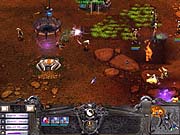
There isn't too much variety in the environments of Battle Realms, but they all look great. The camera is fixed at an isometric perspective, though you can tilt it down at more of an angle. The gameplay runs very smoothly, even with lots of units onscreen, on midrange to high-end systems. You can adjust the detail levels and resolution as necessary, but with everything turned on, the performance was great on a 1GHz test machine. Some users have reported technical issues and crash bugs (the game's readme file addresses some of these), but we experienced no technical problems on two different test systems.
Ultimately, Battle Realms is a distinctive real-time strategy game that's a lot of fun to look at but also a lot of fun to play. However, despite its innovative resource model and its focus on battles between relatively small but highly skilled squads of warriors, the combat itself can feel too frenetic sometimes. Furthermore, as with many other real-time strategy games, you'll find that much of the strategy in Battle Realms lies not on the battlefield, but back at your town, where you constantly have to make judicious use of your peasants and other resources. This is conventional, yet some jaded real-time strategy players might call it patently unoriginal. That would be selling Battle Realms short, though, because other than the familiar balancing act between economy and military, as well as some of the core mechanics, it has refreshingly little in common with other games of its kind. Besides which, its great presentation, genuinely likable units, replayable campaign, and flexible skirmish and multiplayer modes are easily enough to recommend it. And Battle Realms will appeal not just to real-time strategy players in general, but also to those who simply like the martial arts subject matter or even those who wish the strategy genre could stand to have a little more flair--or a lot more flair in this case.